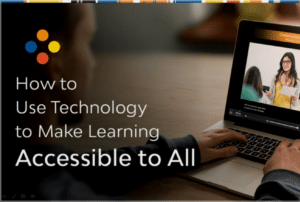A Guide to Video Captioning at the University Welcome to the second installment of Webinar…

How to Implement Universal Design in Education: Webinar Insights
How to Establish Universal Design in Education: Webinar Insights
This installation of the Webinar Insights series will discuss the Jessica Phillips’ guide to establishing a universal design program in higher education, as presented in the webinar: “How to Use Technology to Make Learning Accessible to All.”
Jessica Phillips is a senior instructional designer and initiatives coordinator in the Office of Distance Education and eLearning at The Ohio State University.
She has worked in distance education for eight years and has lead the design of more than 60 online courses.
We will begin by discussing online learning and why accessibility and universal design is important, then segue to Jessica’s three step guide to making accessibility in education a reality.
The Online Learning Environment: What Do We Know?
First, we know that roughly 20% of the population has a disability and when it comes to students, usually only one in five ever tell their instructor that they have a disability. This means that you’ve probably taught, been taught by, or interacted with people with disabilities and you didn’t even realize it.
Second, we know that online learning attracts a wide variety of learners. There are learners who may have attempted a campus classroom and encountered difficulties because it simply didn’t match their learning needs or communication styles. There may also be learners who speak English as a second language and benefit from visual reinforcement.
Third, accessibility is required as a very basic civil right. The ADA and section 504 and 508 of the Rehabilitation Act have guaranteed that for people. But what is most important of all is that accessibility–which we will also refer to as universal design–improves the experience for everyone.
Using the term universal design rather than accessibility is really important. Accessibility often creates sort of a knee-jerk negative reaction, where people think, gosh, well I’ve had maybe one or two students with a disability in my experience teaching–why do I need to do all of this work for a couple of people?

The truth of the matter is that you may have interacted with many people who you didn’t realize had a disability.
Being able to design in an inclusive way, not only helps those with disabilities, but improves the experience for every student.
There has been proven success in driving this initiative forward when speaking in terms of universal design instead of accessibility.
Part of this stems from how we think about accessibility in terms of something to be done at the end of a project, rather than throughout the design of a project. Waiting until the very end does indeed create a lot more work.
Three-Pronged Approach to Universal Design
1. Infrastructure
There must be systems in place to support the acquisition and sharing of new resources. This involves having a one stop shop for people to go to for help articles and step-by-step instructions for making their courses accessible.
To begin building your infrastructure, ask faculty the following questions:

- Who are your students?
- Are a lot of them are going to be English as a second language learners?
- What will the percentage of students with disabilities be?
- Are you going to have students who have limited access to Wi-Fi or a solid Internet connection?
- Do you have students who are working adults and have a lot of different priorities?
All of these things play into how you would design the course to be inclusive and responsive to your students’ needs.
Two major ways to design courses inclusively are to present information in multiple ways and give students multiple ways to show what they’ve learned.
These are both pillars of Universal Design for Learning (UDL) that allow students to tap into their own strengths, communication preferences, and attention preferences. These also minimize any accessibility challenges that students with vision or hearing disabilities may encounter.
So when it comes to course development, asking these questions during the process helps avoid getting to the end of course development and realizing that there are significant issues that will not only be issues for students with disabilities, but will minimize the creativity and the potential for a positive experience for everyone.
2. Outreach
You need to establish open lines of communication and a streamlined way to answer questions so that faculty don’t feel lost when trying to make their courses accessible.
First, ensure direct communications with faculty about course design. A key way to do this is to create “essential questions” that are always addressed during conversations with faculty about course design.
Another way is to weave yourself into conversations that are already happening. This is much easier and more successful than trying to create new conversations around universal design. For example, when creating quality assurance standards for courses, accessibility and universal design can be woven into those checkpoints.
Second, create a strategy for budget talks. Budget is a huge roadblock for many universities’ accessibility initiatives. The best strategy to use when entering into budget talks is to explain the benefits of universal design for all students and most importantly, highlight its ability to mitigate financial risk in the future.

Retroactively fixing courses and materials for accessibility can be a very costly endeavor, especially compared to the cost of incorporating universal design from the beginning.
Furthermore, the DOJ is cracking down on accessibility more than ever, with numerous schools, such as Berkeley, most recently, being served with hefty lawsuits.
Lastly, always address accessibility when doing RFPs, RFIs, and new vendor acquisition. There are a lot of third party companies that offer great solutions for more engaging online classes, but not all of those companies are considering accessibility–because no one is asking them to.
It is critical to start having conversations with vendors about accessibility and to educate them about what the law requires.
This means asking accessibility questions before anything is signed, and spelling out the accessibility requirements that must be met for their product to be used in your courses.
3. Empowerment
Universal design initiatives should not be led by one person, rather everyone should take some ownership over accessibility.

The best way to encourage this is to use a marketing strategy where you showcase the champions who are doing good.
This can involve creating a task force of people willing to help drive the initiative forward and marketing their stories.
Another tactic is to add these stories to the conversations that are already happening across your institution.
Think about which stories will inspire action; is it the the ones about mitigating risk, the ones about real students who have disabilities, or the stories about universal design being successful?
Inspiring a call to action university wide, not just with one person or department is a key point. As is leveraging the champions, so that the people who are doing things right have a platform to talk more about their successes.
Summary
If you are looking to make your institution’s courses accessible, using the three-pronged approach can help you successfully initiate a universal design program.
Remember that the online learning environment is home to a variety of students who may have disabilities, different learning styles, and different levels of English acquisition.
Accessibility is a necessary part of designing courses, but it is often overlooked. Presenting accessibility in terms of universal design speaks to its ability to help everyone, not just students with disabilities, and relays that it is an ongoing design process from the beginning, rather than an afterthought.
Using the three-pronged approach, comprised of Infrastructure, Outreach, and Empowerment, has been successful at universities such as The Ohio State University.
We hope these tips help you create a universal design initiative that sees real progress.




